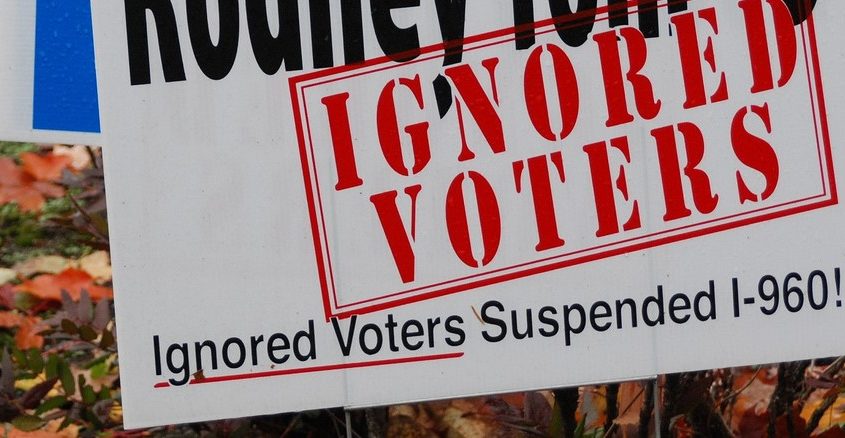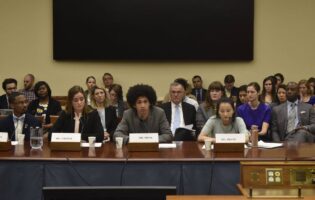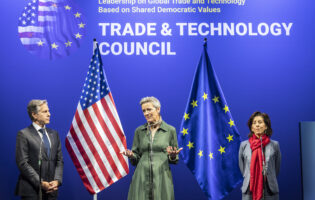
A McLin on Flickr. Original photo has been modified
Negative Campaigning in the U.S Midterm Elections: Role Model or Warning for German Campaign Strategies?

Susanne Thelen
Institute of Political Science at the University of Technology Chemnitz
Susanne Thelen was a DAAD/AICGS Research Fellow from October to December 2018. She is currently a doctoral candidate at the Institute of Political Science at the University of Technology Chemnitz. Her PhD is about campaign strategies, especially “negative campaigning” in the 2017 German federal election.
Before beginning her PhD, Ms. Thelen interned at the Konrad Adenauer Foundation in Washington, DC, during the 2016 presidential election. Her Master’s thesis analyzed the Twitter attacks by presidential candidates Donald Trump and Hillary Clinton. In 2017, she worked for the CDU Department of Campaigning & Advertisement during the German federal election to continue her research about election campaigns.
Ms. Thelen lives in Rhineland-Palatinate and is a member of the CDU and a member of the State Executive Board of the CDU in Rhineland-Palatinate. She worked as a Retail Business Management Assistant, studied Business Administration and Marketing (BA), and holds a Master’s in Politics and Communications from the University of Trier.
During her time at AICGS, Ms. Thelen will focus on the differences between German and American campaign strategies. She will examine U.S. campaign strategies and American influence on German campaign strategies, including the ways in which they may serve as role models to some German parties. Moreover, the midterm elections in November 2018 may provide new perspectives on “negative campaigning” or other campaign strategies. Negativity in election campaigns is a part of political culture. While in Washington, Ms. Thelen will discuss this issue with other researchers, professors, and political experts, among others, investigating whether there are similarities or discrepancies between electoral campaigns in Germany and the U.S.
Negativity has always been a part of American election campaigns. As early as 1828, President Andrew Jackson invented “coffin handbills”—similar to what we would call a flyer or pamphlet today—to list the negative characteristics of his opponent, John Quincy Adams.
Now, almost 200 years later, candidates have more options to spread their negative messages than simply using pamphlets. Campaign speeches, debates, social media platforms like Facebook or Twitter, and attack ads on the radio and TV generate a picture that political attacks have increased, not only in quantity, but also in intensity. By taking a closer look at the 2018 midterm elections, we see negativity playing an influential role in campaign strategies.
An analysis by the Wesleyan Media Project indicates that not only has the sheer number of TV ads increased, so, too, has the number of negative TV ads.[1] In the 2018 midterm elections, 69 percent of the aired ads implied an attack, which is less than the nearly 75 percent of negative ads in 2010. However, compared to past elections, the total number of negative ads increased: This year, nearly 569,000 attack ads aired between Labor Day (September 2) and Election Day (November 6), breaking the 2010 record of nearly 450,000 attack ads.
What Defines “Negative”?
What do we mean by “negative”? How do we measure negativity? The above-mentioned analysis by the Wesleyan Media Project distinguishes between direct attacks and contrast attacks that mention both the favored and targeted candidate. This is one opportunity to get closer to defining negativity.
Researchers such as Richard Lau and Gerald Pomper define negative campaigning as “campaigning that attacks or is critical of an opposing candidate.”[2] Similarly, John Geer, professor at Vanderbilt University argues, “negativity is any criticism by a candidate leveled about another candidate.”[3] This does not consider if the attack is a contrast or a direct attack, if it focuses on policy or character characteristics, or if it can be seen as fair or unfair.
One positive aspect of negativity in an election campaign is that negative messaging often is more informative than some other forms of campaign communications because negative ads require “proof,” more specific facts, and better documentation. An attack on an opponent requires at least some evidence to corroborate the argument, or else it risks backfiring. Moreover, negative statements get more attention from the public or the media because they are often more entertaining, and the media can realize a higher profit out of entertainment. It is the same reason that we remember a good fight in sports or politics—people remember conflict and contrast much more than comity.
However, because negative campaigning arouses voters’ emotions, candidates must be careful. Distrust and false information may damage the relationship between candidates and their voters as well as between parties or even countries. A false use or the distribution of untrue or unfair information can manipulate voters in an inappropriate way, and unverified accusations usually have a so-called “backlash effect,” with no good outcome for the attacker.[4] Therefore, other researchers argue that attack ads divide society, have negative implications for democracy, and depress voter turnout.
Not all attacks are the same: they can be implicit or explicit, they can be direct or comparative, but they must at least address the opponent in some way. Moreover, ads differ in tone: is it strident or not, is it fair or inaccurate.
Trait Attacks
For most people, negative campaigning equals “below the belt” attacks by one person against another person’s character. This means someone’s trustworthiness, reliability, credibility, or honesty is at the center of these trait-based attacks. One example: in the 2018 midterm election, Beto O’Rourke of Texas, who had fallen behind Senator Ted Cruz in the polls in their hotly contested Senate race, attacked his opponent’s honesty and character, saying “Ted Cruz is for Ted Cruz” and “all talk and no action,” while talking about abortion, climate change, and other red-versus-blue divides.[5]
Moreover, O’Rourke also referred to the nickname Donald Trump used against the Texas senator in the 2016 presidential race: “He’s dishonest, and it’s why the president called him ‘Lying Ted,’ and it’s why the nickname stuck—because it’s true.”[6]
Insulting someone’s character or personality was “trendy” in the 2018 midterm election. In some races, candidates noted an opponent’s ethnicity in their messaging. For example, the governor’s race in Florida was closely contested between Ron DeSantis, Representative for Florida’s 6th congressional district, and Andrew Gillum, the African-American Democratic mayor of Tallahassee. When DeSantis said, “the last thing we need to do is to monkey this up by trying to embrace a socialist agenda with huge tax increases and bankrupting the state,” he was heavily criticized for using the expression “monkey,” a racially-charged insult against African-Americans.
Issue Attacks
Another style of messaging is attacks with issue-related content. They refer to a candidate’s political positions, leadership quality, stamina, or record of “flip-flopping” within the decision-making process. For example, does the candidate have relevant professional experience? Is the politician able to solve problems like unemployment, climate change, or gun violence?
This is what happened in Denver, Colorado. Republican congressman Mike Coffman’s reelection campaign against Democrat Jason Crow focused on their differences on health care, immigration, and gun control. Gun control was an especially sensitive issue in the district, where 12 people were killed in an Aurora movie theater in 2012 and where 13 people were killed at Columbine High School in 1999. Coffman opposed blanket gun restrictions, but a Super PAC supporting Democrats produced the TV ad “enough is enough.”[7] In this ad, Crow blamed Coffman for his “failed leadership,” and said that he is “doing nothing” and has “taken more money from the NRA than any other congressperson in Colorado.” Perhaps Crow hit a nerve with his campaign: in the end, he beat Coffman, 53.7 to 43.4 percent.
Value Attacks
The November 2018 midterm campaigns show another aspect of negativity that fits under neither “character attacks” nor “issue-based attacks.” A lot of political ads targeted a candidate’s nationality, race, connection to religious groups, or purported attitude toward America. These attributes may be summarized as a third dimension on negativity called “value attacks.”
In one strongly contested race in Ohio, Representative Steve Chabot used a “value attack” against his Democratic opponent, Aftab Pureval. Chabot claimed that his challenger worked at a law firm that “made millions helping Libya” and that was responsible for “Americans killed by Libyan terrorism.”[8] The keywords referring to the value dimension in this ad are “American” and “terrorism.” The American people are proud of their country, American values, and the military. Saying that Pureval’s actions in the past could damage these values and support terrorism was an attack on his values, although there was no evidence that Pureval had any direct connection to the incidents alleged. In the end, Chabot was re-elected, with 52 percent to Pureval’s 46 percent.
Attempts to link a candidate to terrorism by an opponent were also seen in a congressional race in California. Ammar Campa-Najjar was accused of being an Islamic terrorist sympathizer because a part of his family was involved in an assassination at the 1972 Olympic Games in Germany. In reality, Campa-Najjar, a Christian who grew up in a Mexican-American community, had long ago distanced himself from that wing of his family. Even while calling the Democrat a “national security risk,”[9] Representative Duncan Hunter himself was under legal pressure for misuse of campaign funds. In the end, although he won by a much smaller margin than in 2016, Hunter was re-elected.[10]
Abigail Spanberger, a former CIA case officer, had to fight similar accusations. The Democrat running for Virginia’s 7th House district was attacked for teaching at a Muslim high school in 2002. One ad alleged: “One graduate plotted to assassinate President Bush. Another was arrested for trying to bring a butcher knife on an airplane. So dangerous […] but Abigail Spanberger cashed her paychecks like nothing was wrong.”[11] Campaigns use terrorism because they believe it is a threat to national security, and with that to American values. In the end, Spanberger won in Virginia, 50.3 percent to 48.5. In his written statement, her opponent Dave Brat blamed political advertising and the media, saying that he lost, “In the face of millions and millions of dollars of money from around this country that poured into Virginia to attack my record.”[12] Although this might appear disingenuous, since the Republican’s campaign pressed this attack on Spanberger, Brat makes an important point—how candidates or parties raise and spend money is one of the main differences between American and German campaigns.
A Positive Fight
After all of these examples of negativity, it is worthwhile to highlight a candidate who at least tried to run a positive campaign. Amy McGrath, Democratic candidate for Kentucky’s 6th congressional district, pledged to refrain from making attack ads. Instead of negativity, her campaign focused on her personal and professional life: McGrath served as a fighter pilot in the Marines, where she flew 89 combat missions in her 20 years of service, including in Iraq and Afghanistan. Her campaign focused on her military career and the barriers she broke for women, and her website shows many pictures of McGrath in her uniform or in the classroom at the U.S. Naval Academy, where she taught before running for office. Other pictures and ads paint McGrath as a mother and wife with her husband, two sons, and one daughter at her side.[13]
Staying positive includes the risk of not getting as much attention as negative campaigning might generate. But McGrath insisted that she wanted to make “a statement”[14] by not resorting to pure attacks. However, she did not ignore her opponent and indeed used negative techniques in contrasting their different opinions. For example, in her television ad “Goalkeeper,”[15] McGrath demonstrated her abilities in soccer while the ad warns that her opponent, Republican incumbent Andy Barr, is a risk for the people of Kentucky. McGrath was not just defending the goal in soccer, but also in real life.
Barr aired some positive spots as well, but he invested $1 million on negative ads and was supported by the Super PAC “Congressional Leadership Fund,”[16] which spent more than $2 million in roughly the last six weeks of the campaign on ads attacking McGrath, including one that asserted “Amy McGrath is wrong on illegal immigration. Amy McGrath is wrong on national security. McGrath is with Hillary and the Washington elites, not Kentucky.”[17]
Barr’s attack ads characterized McGrath as “too liberal for Kentucky.” In addition, he claimed McGrath supports “taxpayer-funded abortion at any time, for any reason.”[18] In the end, the race between Barr and McGrath became one with the highest concentration of political ads in the country, with roughly 24,000 ads costing nearly $9 million.[19]
Even The New York Times picked up the race between McGrath and Barr. One headline read “Amy McGrath Is Avoiding Attack Ads. Can a Congressional Candidate Win Without Them?” The answer to this question after November 6 based on her personal experience may be no. Although McGrath ran a positive campaign and tried to avoid negativity in her ads, she did not win the House seat. Instead, Barr was reelected by 51 percent, a marked decrease from Barr’s 60 percent in the previous election.
A Role Model or Warning for German Campaign Strategies?
The 2016 presidential election taught us that facts and accuracy often are secondary considerations when it comes to negative ads. Both Donald Trump and Hillary Clinton accused each other of lying, corruption, or being unfit for office. Even as president, Trump ran “us-against-them” rallies during the midterm election. Provoking with “fear, nationalism and racial animosity,”[20] Trump changed the rules of negative campaigning. The 2018 midterm election demonstrated that negative campaigning still is a popular campaign strategy.
In Germany, campaigns with this “American style” are unlikely to become the norm for several reasons. First, the party system is different. With six main parties competing, it would be difficult to focus on one to attack, especially because parties have to build coalitions after elections to govern the country. Second, half of the candidates for the federal parliament (Bundestag) are not directly elected. In contrast to the U.S., voters in Germany vote for parties, not for candidates, at the federal or state level. Keeping that in mind, attacking the top candidate is not enough. After twelve years of Angela Merkel and the conservative, center-right Christian Democratic Union (CDU) in power, the CDU’s 2017 campaign focused on keeping the very popular chancellor in office. The Social Democratic Party (SPD) also used the strategy of personalization. Its top candidate and party chair during the election campaign was former President of the European Parliament, Martin Schulz. Although the German campaigns focused on their top politicians, the messages differed from American campaigns. German campaigns are less personal and more issue-based. Personal attacks—about one’s appearance, family life, education, health, or past legal or financial problems—are far less common than issue attacks dealing with qualifications, political experience, leadership qualities, and stances on key policies. Negative attacks specifically referring to personal attributes instead of political content are considered dirty campaign strategies, and rarely seen. This is further reinforced by, third, the different funding and data laws for parties in Germany, as some campaign strategies like microtargeting or Super PACs are forbidden or nonexistent.
In Germany, the opposition parties like the Left or the Greens are more likely to use negative tactics against the ruling parties. With the rise of populism and the far-right Alternative for Germany (AfD), issues like immigration have been at the fore, and the AfD employs similar tactics to those used in the U.S. 2018 midterm election, arguing against the “elite,” against migrants, and against the chancellor. This shows us that negativity as a campaign strategy is gaining ground.
Conclusion
In conclusion, there are some nuanced similarities between German and American campaign strategies. Negative messaging is used in both, but German campaigners focus on issue attacks rather than on trait attacks. Although in the U.S. attacking the personal attributes of one’s opponent seems to be a common tactic, in both countries we can acknowledge an increase in value attacks. In the 2018 midterm elections, for example, attack ads made race or nationality a topic of discussion; in the 2017 German federal election, the AfD pushed the conversation toward discussing whether immigrants accept German values and traditions.
In considering whether negative campaigning in the U.S. midterm elections is a role model or warning for German campaign strategies, the answer could be: it is more a threat than a good example. The rise of populist parties in Europe, the Brexit vote, the 2016 U.S. election, and the difficulties forming a government in Germany after the 2017 federal election have proven that distrust and false information are gaining ground and may damage the partnership between countries like the U.S. and Germany—with a long-term effect. With that in mind, negativity should always be used carefully; it is easier to destroy trust than to rebuild it.
Supported by the DAAD with funds from the Federal Foreign Office (FF).
[1] See “61% Increase in Volume of Negative Ads,” Wesleyan Media Project, October 30, 2018. They measure, among other things, the tone of the ad, whether the ad uses magic words, whether the favored candidate narrates the ad, what endorsements (if any) are mentioned, music, gender of the narrator in voiceovers, and what issues are discussed.
[2] Richard R. Lau and Gerald M. Pomper, “Effectiveness of Negative Campaigning in U.S. Senate Elections,” American Journal of Political Science 46:1 (2002), p. 47–66, p.48.
[3] John G. Geer, In Defense of Negativity: Attack Ads in Presidential Campaigns (Chicago: University of Chicago Press, 2006), p. 23.
[4] Richard R. Lau, Lee Sigelman, and Ivy Brown Rovner, „The effects of negative political campaigns: A meta-analytic reassessment,” Journal of Politics 69:4 (2007), p. 1176.
[5] The battle between Mr. Cruz and Mr. O’Rourke captivated and polarized Texas and drew enormous interest nationwide, with the candidates raising far more money than those in typical Senate races. Mr. O’Rourke raised a record-breaking $38.1 million in the last three months alone, the most of any Senate candidate ever.
[6] Manny Fernandez and Mitchell Ferman, “Beto O’Rourke Attacks Ted Cruz as ‘Dishonest’ in Debate in Senate Race,” The New York Times, October 16, 2018.
[7] Jason Crow for Congress, “Enough” Campaign Ad, February 21, 2018.
[8] CLFSuperPAC, “OH-01: He Should Know” Campaign Ad, August 29, 2018.
[9] Jennifer Steinhauer, “Duncan Hunter Airs Ad Suggesting Opponent Is Terrorist Sympathizer,” The New York Times, September 28, 2018.
[10] Hunter won in 2016 with 63.5 percent of votes. His share in 2018 was 56.5 percent.
[11] Laura Vozzella, “Saudi school dominates TV ads in race for suburban Richmond congressional seat,” The Washington Post, September 11, 2018.
[12] Laura Vozzella, “Rep. Dave Brat concedes to Democrat Abigail Spanberger in Va.’s 7th District,” The Washington Post, November 7, 2018.
[13] See Amy McGrath for Congress: About.
[14] Michael Tackett, “Amy McGrath Is Avoiding Attack Ads. Can a Congressional Candidate Win Without Them?” The New York Times, October 10, 2018.
[15] Amy McGrath for Congress, “Goalkeeper” Campaign Ad, September 24, 2018.
[16] The Congressional Leadership Fund is a Super PAC aligned with former Speaker Paul Ryan.
[17] “New Ad in KY-06: Amy McGrath is with the Washington Elites, Not Kentucky,” Congressional Leadership Fund, October 31, 2018.
[18] Andy Barr, “Any Time Any Reason” Campaign Ad, October 2018.
[19] Numbers include ads aired on broadcast television between January 1, 2017 and October 25, 2018. See “61% Increase in Volume of Negative Ads,” Wesleyan Media Project, October 30, 2018.
[20] Ibid.








